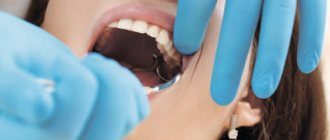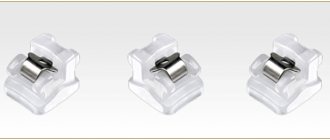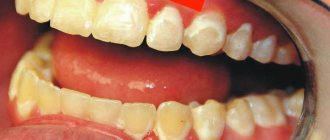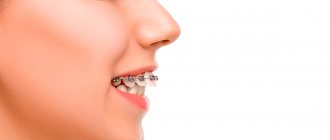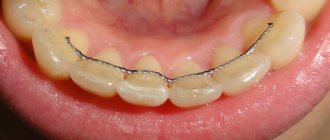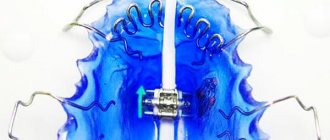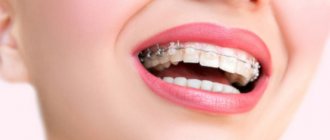Many people dream of a gorgeous smile. But not everyone gets it from birth. You have to put in a lot of effort to achieve the desired result. A smile helps a person make contacts in society, even build a career.
One of the methods of obtaining a correct bite is correction with braces. Even though this is a slow method, the end result lasts a lifetime.
There are situations in medical practice when braces cannot fully realize what they want on their own. In such cases, orthodontists resort to the use of additional means. For complex malocclusion defects, traction for braces or, as they are also called, elastic bands are used. Installing elastic bands on braces is the next step in wearing braces, after the patient gets used to wearing them.
Rubber bands for braces: what is it?
The materials used for the production of elastics are safe for health and do not cause allergies.
An elastic band for a brace, or orthodontic rod, is an elastic ring that is installed on braces to hold the jaws together.
Such rings can have different diameters and thicknesses, and their function is to move the teeth in the required direction.
They are made of smooth material, which helps prevent the formation of damage and burrs on their surface.
The materials used to produce elastics are safe for health and do not cause allergies.
Important: To achieve the desired result, you need to ensure that the elastic bands are put on correctly. Therefore, it is advisable that such devices be worn by an orthodontist.
Elastic force components
Elastic power components are designed to hold the arch of an orthodontic structure and are used after aligning the dentition. These include: chains, threads, rods.
According to the degree of impact, elastics of low, medium, and high amplitude forces are distinguished. The pressure from using elastic bands does not exceed 20-25 g/mm2. The use of excessive forces leads to complications, so high-amplitude elastics are rarely used.
Chains
Chains (transparent, gray, colored) - rings connected into a single system.
Elastic chains are used for:
- closing gaps between teeth;
- closing gaps after tooth extraction;
- rotating the tooth around its axis;
- movement of teeth.
Threads
Thread is considered an alternative to chain. Thread functions:
- movement of teeth;
- eliminating gaps and cracks;
- reduction of dentition;
- stretching of undetected teeth.
Traction
Tractions are used to correct intermaxillary contacts. They vary in diameter and thickness. Each diameter and strength corresponds to the name of the animal. This is designed for ease of use for both doctors and patients.
Braces are used on teeth in the presence of the following pathologies:
- distal bite;
- mesial bite;
- crossbite;
- open bite;
- lack of contact between the teeth of the upper and lower jaw in a certain area of the row;
- pulling out teeth that have not fully erupted.
The brace system performs the main part of the work of correcting defects; elastics are an additional tool that enhances the effect of the orthodontic structure.
Although the treatment requires a lot of time and patience, in the end patients are able to enjoy a new smile for a lifetime.
Operating principle
To fasten the elastic bands, brace clasps located on both sides of the jaws are used.
Elastic bands must be worn with braces for a long time. Only in this case can the desired result be achieved.
The use of such devices helps control the process of jaw movement, which allows you to gradually change the position of the rows.
Thanks to the additional force created by the thrust, a significant reduction in the time required to correct the defect is achieved.
To fasten the elastic bands, brace locks are used, located on both sides of the jaws.
Intermaxillary traction for braces
Intermaxillary cutters for braces have the following features:
- The elastic band does not touch the gums, so it does not injure or rub their tissue.
- If one of the rubber bands breaks, a new one must be installed as soon as possible to ensure symmetrical movement of the jaws.
- The rods firmly connect the jaws, while at the same time not interfering with the free movement of the lower jaw.
- Properly secured elastic bands should not interfere with eating or talking. To do this, you need to adjust the tension force so that it is equal on both sides.
- Most people quickly forget about the presence of a foreign object in the oral cavity.
Kinds
Elastics are made in different colors, but the most popular among them are white, transparent and yellow.
Also, elastic bands may differ in:
- Pulls are used to correct the direction of the jaw and provide additional effort when moving the jaws
Elastic force.
- Diameter.
- Thickness and length of the product.
Due to constant significant loads on the elastic bands, over time they lose their elasticity and do not have the desired effect in correcting the bite.
Therefore, rods should be periodically replaced and new ones installed.
Depending on the design of the device and the method of fastening, the following types of elastic bands for braces are distinguished:
- traction;
- elastic rings;
- ligatures;
- chains.
Traction
Cutters for braces are elastic rings that can be installed either directly into the oral cavity or located outside it.
The dentist decides which specific structure is more appropriate to install in a particular case, based on the individual characteristics of each patient.
Pulls are used to correct the direction of the jaw and provide additional effort when moving the jaws. As a result, unevenly located teeth move into the “correct” place, and the jaws interlock with each other.
Tractions are used only after completing the main part of the treatment of dental defects.
The rods must be installed by a specialist, since only he knows how to do it correctly
Ligatures
Ligatures consist of an arch designed to hold teeth in the desired position. The special design of this type of device does not allow the arch to slide over the surface of the teeth and securely lock in the correct position.
Ligatures can be made in the form of:
- Rubber rings.
- Thin metal (steel, silver or aluminum) wire.
Ligatures are designed to fasten braces into a single continuous row. As a rule, most people prefer ligatures made of transparent material - this allows you to visually disguise the presence of an orthodontic structure in the mouth.
However, it should be taken into account that over time, transparent elements may turn yellow due to contact with food, and become yellowish or even brownish. To avoid this, many patients, especially young people, choose multi-colored elastics, since it is almost impossible to bleach elastic bands.
Transparent ligatures are often placed - this allows you to visually disguise the presence of an orthodontic structure in the mouth
Elastic chains
Devices such as chains allow you to achieve the following results:
- Change the position of one or an entire group of teeth.
- Eliminate gaps between teeth.
- Align and strengthen teeth.
Elastic chains are sold wound on spools. The standard length of one such product is 4 m. Just like rods and ligatures, chains are available in different colors.
As for transparent and gray chains, they are divided into the following types:
- Without a gap - used to correct tightly spaced teeth, without gaps, or in cases where the existing gaps have a minimum distance. In addition, this type of chains is also used on small teeth, for example, on the incisors of the lower jaw, or when there is a need to create a significant traction force.
- With a medium pitch - they contribute to the creation of a medium degree of force and are suitable for the correction of teeth of normal sizes.
- With a wide step - they have the least traction and elasticity. They are used on large teeth, or when there is a large distance between braces.
Colored chains are available in only two varieties:
- No gaps.
- With a medium step.
To fix individual links of the chain, special hooking elements can be used, or the links can be wound and fastened around the braces.
The advantage of chains compared to other types of elastics is their resistance to rapid loss of traction force.
To fix individual links of the chain, special hooking elements can be used, or the links can be wound and fastened around the braces
How to wear orthodontic bands
The patient attaches intraoral and extraoral elastics to the hooks of the brackets, buccal tubes, and clamping hooks on the archwire. Elastic bands for braces move teeth in a given direction while strictly following the doctor’s recommendations.
Treatment time is reduced if the patient follows three rules.
- Relieves cravings only before eating and brushing teeth.
- Changes rubber bands for braces twice a day: morning and evening. Elastics lose strength after twelve hours of tension.
- If the elastic breaks on the left or right, changes both rods to maintain the symmetrical action of forces.
Patients easily attach the elastics to the hooks. The sensations after installing the rods depend on the patient’s pain sensitivity threshold. Elastic bands can cause discomfort similar to the sensations after having braces installed. The slight aching pain from the action of elastics on the teeth stops within a few hours. Elastic bands are worn from a month to a year, depending on the complexity of the clinical case and the patient’s compliance with the doctor’s recommendations.
How to choose?
When choosing which rubber bands to use for braces, you should pay attention to the following indicators:
- Mounting method.
- Diameter of the rubber ring.
- Product thickness.
Marking system
When choosing orthodontic elastic bands, the main parameters are thickness and diameter
Since when choosing orthodontic elastic bands, the main parameters are thickness and diameter (and it is these indicators that affect the tensile strength), for convenience, special markings are used with images on the packaging of a particular animal.
For example:
- ostrich (2 OZ/60g);
- chipmunk (3.5 OZ/100g);
- antelope (6 OZ/170g).
Mounting methods
In order to get the maximum result after wearing braces, you should properly secure and tighten the elastics.
So, in orthodontics there are the following methods of attaching elastic bands:
- V-shaped.
- Box-shaped.
The V-shaped method involves securing an elastic band like a tick. In this case, the elastic acts only on two teeth, attracting them to each other.
The box method is used to tighten indivisible dental blocks. The rubber band is stretched in a square shape to move an entire block of teeth into the desired position. As a rule, this method is used only on the back teeth.
Box-shaped
V-shaped
Why do you need rubber bands on braces?
Each type of elastic band performs its own specific function, but in any case they improve and speed up the treatment process. The effect of the arc is aimed not only at pulling teeth into the required position, but also enhances correction in the most problematic areas.
The following functions of elastic bands for braces are highlighted:
- Strong fastening of the arc and plates to each other.
- Increasing the effectiveness of the braces themselves.
- Additional correction for individual problem teeth.
- Acceleration of the treatment process.
How to use wax for braces
Using elastic bands, an experienced doctor controls the position of the bite and influences the restoration process until the best result is obtained. To do this, you need to choose the right type of fastening and tension force. Under no circumstances should you tighten the rubber band, as such treatment can only cause harm.
If the elastic has slipped on one side, you need to put it back in place or remove the same one from the other side. But in case of removal, it is necessary for the doctor to urgently put the elements in place.
How to wear it correctly?
To ensure that your teeth look perfect after wearing braces, it is recommended to choose an orthodontist who has extensive experience.
Only an experienced specialist will be able to correctly determine the cause of the pathology and select exactly the treatment regimen that suits each individual patient.
Of no small importance in achieving the desired effect is the correct fastening of the rubber rods according to the instructions:
- The elastic bands must be simultaneously attached to both the lower and upper jaws
The elastic bands must be simultaneously attached to both the lower and upper jaws.
- The pressure created by the rods should be distributed evenly over the surface of the chewing organs.
- After installing the structure, the patient should feel a slight tension, which does not cause him discomfort.
- To ultimately get an attractive smile, the rods must be fixed symmetrically on both the right and left.
If the teeth are significantly crooked, the doctor can correct individual areas one by one, which can lead to an increase in treatment time.
Wearing rules
Anyone who wears braces with traction must adhere to the following rules:
- While wearing orthodontic appliances, patients should not frequently eat solid foods.
Elastics must remain on braces 24/7. They can only be removed while brushing your teeth.
- Under no circumstances should you try to relieve the pressure on your own by moving the rubber bands.
- While wearing an orthodontic structure, patients should not frequently eat solid foods - nuts, crackers, etc., as this can lead to accelerated wear of the elastic bands.
- It is advisable to always have an extra pack of rubber bands in stock.
- If the tension is greatly weakened, you should visit a doctor who will select other traction.
How much to wear
The period of use of elastic bands for braces is prescribed by the doctor based on the anatomical features of the jaw and the complexity of the identified disorders; they should be worn until the end of treatment. The minimum period is three weeks, often extending to several months. In the most difficult situations, treatment can last from one to three years.
These elements are replaced approximately once a month, but a more precise period is prescribed by the treating specialist. It is not recommended to delay visiting a doctor, as this can lead to relaxation of the tension, and then the treatment will be ineffective.
Self-replacement of orthodontic elastics
Patients can replace worn rubber bands themselves. The method of attachment must be determined by a doctor. But before changing them, you need to familiarize yourself with the technology of their correct fastening.
Step-by-step instruction
Let's look at it step by step:
- When installing elastics, ensure the correct distribution of tension force
The braces are equipped with special hooks designed to fix rods on the structure. The elastic bands must be worn on both jaws at the same time.
- When installing elastics, make sure that the tension force is distributed correctly.
- For proper treatment of an abnormal bite, it is important to ensure that the elastic bands are located symmetrically in the oral cavity.
- After the elastic bands are installed, you need to make sure that they do not create obstacles when opening the mouth. There should be no difficulty in talking, chewing and swallowing food.
What to do if the rubber band comes off?
If the elastic has come off the bracket, you should find out why this happened. If the rubber band is worn out, it is replaced with a new one.
If the reason for this is the failure of the hook on the brace, you need to seek help from a doctor who will correct the malfunction of the structure.
Under no circumstances should you try to bend or straighten the hooks yourself - this can lead to damage to the orthodontic system!
